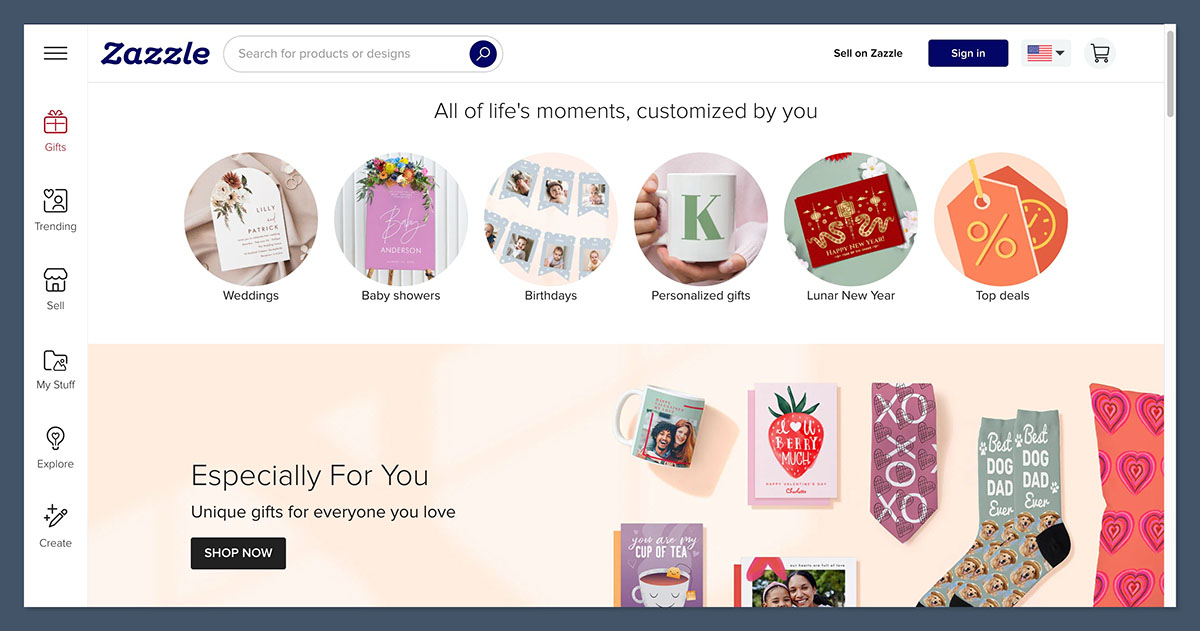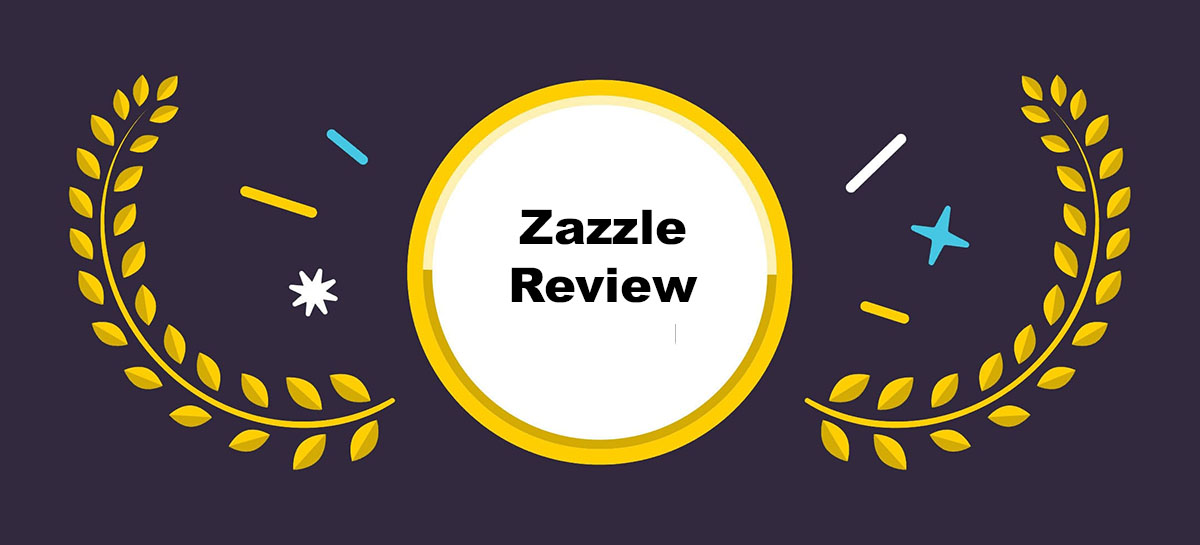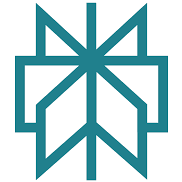Quick Answer:
Zazzle can be a decent platform for passive POD income — but only if you’re playing the long game. It’s free, offers a massive marketplace, and supports a wide range of products.
But the competition is brutal, and the design tools feel dated. It’s great if you’re not relying on it as your primary income stream, but it’s far from the best platform if you’re trying to scale fast.
I’ve tested Zazzle alongside other major POD platforms like Redbubble, Etsy, Amazon Merch, and Printful — and while it’s not built for high-volume sales, Zazzle stands out for passive income potential in niche, customizable categories.
In this review, I’ll walk you through Zazzle’s product range, seller experience, royalties, and how it compares to other POD platforms, so you can decide if it’s the right fit for your print-on-demand business.
What Is Zazzle?

Zazzle is a free print-on-demand marketplace that specializes in personalized gifts, event products, and stationery, offering sellers an easy way to create and sell custom items without worrying about inventory, shipping, or customer service.
Here’s how it works:
- You upload your artwork or designs
- Pick which products you want them printed on
- Set your royalty rate (how much you earn per sale)
- Zazzle handles fulfillment, printing, shipping, and customer service
It’s entirely free to set up a store and start selling.
You won’t deal with order management or inventory. It’s truly hands-off after uploading — but that also means you’re 100% reliant on Zazzle’s traffic and SEO.
You won’t own the customer or their data. Everything lives within Zazzle’s platform.
Pros and Cons
Pros
- 100% free to use
- No customer service or shipping
- Huge product variety (1,000+ SKUs)
- Customization built-in for end-users
- Decent marketplace traffic
Cons
- Design tools are clunky
- Very saturated — hard to stand out
- Royalty system punishes high margins
- No branding or customer ownership
- Product listings can’t be bulk-managed
This isn’t the best POD platform if you want full control or are building a brand. But it’s a solid option to add passive revenue to your POD stack.
My Experience Using Zazzle as a POD Seller
I decided to test Zazzle for 6 months.
My goal: compare it to Etsy, Redbubble, and Shopify POD. I wanted to see how it performs in real time — not just from YouTube reviews or Reddit threads.
Setup
Getting started was simple. Zazzle doesn’t ask for payment details or business registration upfront.
- Signing up was easy. No credit card needed. You just create an account, choose a display name, and you’re good to go.
- Creating a store was straightforward, but the interface feels clunky compared to platforms like Etsy or Shopify. It’s not intuitive, and the dashboard looks like it hasn’t been updated in years.
- Uploading designs took longer than expected. Their product editor is very manual. No bulk upload or smart syncing. I couldn’t copy settings from one product to another. Every product needed a new setup from scratch.
- You have to adjust placements on every single product variant. It’s slow. If you want your design on 10 t-shirt styles, mugs, tote bags, and notebooks — you’ll be tweaking sizes, alignments, and colors for each one. Multiply that by 60 designs, and it adds up fast.
Once you’re done uploading, the listings go live almost immediately — no approval wait, which is nice.
But don’t expect design feedback or optimization prompts like you’d get with Printful or Redbubble.
Product Customization

Zazzle is built for high customization — and that’s both its biggest feature and biggest headache.
Customers can personalize your products directly:
- Add or replace text
- Change fonts and colors
- Upload their own images
- Move elements around
This is amazing for event-based products like wedding invites, birthday cards, and gifts — but it does come with friction.
- It adds friction to the buying process. Some users don’t want to customize — they want “ready to go” products.
- Your original design might get butchered. Customers often move things around poorly, then blame you when it looks off.
- Some customers expect you to “fix” their tweaks. I had a buyer message asking for help aligning their name on a mug — even though they’d changed the layout themselves.
Zazzle does give you the ability to lock elements in place, but only to an extent. If your niche requires tight branding or layout control, this feature can be limiting.
My Store Performance
To test the platform properly, I uploaded 60 designs across different product types. I wanted to compare how mugs, shirts, and stationery performed.
The results were interesting:
| Product Type | # of Designs | Sales Volume | Revenue | Notes |
|---|---|---|---|---|
| Mugs | 20 | 9 | $72.45 | Moderate interest, especially gifts |
| T-Shirts | 15 | 3 | $47.10 | Low margin, saturated space |
| Wedding Stationery | 25 | 20 | $78.45 | Clear winner, consistent traffic |
Here’s the snapshot from my 6-month test:
- After 2 months: 5 sales
- After 6 months: 32 sales
- Revenue: $198
- Profit: $56 (after Zazzle fees and royalty cut)
That’s with zero promotion, ads, or SEO. Everything came from Zazzle’s internal traffic.
Was it life-changing? No. Was it passive? Completely.
After I finished uploading, I didn’t touch it again. The fact that I still made sales without lifting a finger says a lot about Zazzle’s organic potential.
But the low margins and slow pace make it more of a side hustle than a scalable POD business.
What Sells Well on Zazzle?
Zazzle isn’t your typical t-shirt POD site.
It’s not built for trendy fashion or viral meme tees. Instead, it thrives in one specific lane: personalized, event-driven products.
Zazzle’s marketplace leans heavily into customization, and that shows in what actually performs well.
If you’re looking to sell basic apparel or generic wall art, this isn’t the best platform. But if you focus on products tied to life moments and personalization, there’s real potential.
These are the categories where I consistently saw traffic and sales:
- Event-based products: weddings, baby showers, birthdays, graduations
- Stationery: invitations, greeting cards, thank-you notes, RSVP cards
- Gifts: personalized mugs, keychains, photo frames, keepsakes
- Office supplies: planners, notebooks, calendars, business cards
What makes Zazzle unique is how deep each category goes. For example, under “wedding stationery,” there are entire sub-niches: save-the-dates, rehearsal dinner invites, bridal shower thank-yous, and so on.
Best-Selling Niches on Zazzle (Based on Marketplace Trends)
From both my own store data and what consistently shows up on the homepage or trending tabs, here’s what sells well:
| Category | Why It Sells Well |
|---|---|
| Wedding Invitations | High demand all year round, customers expect full personalization |
| Mugs | Easy gift, low cost, editable with names or messages |
| Calendars | Seasonal, practical, often personalized with family photos |
| Greeting Cards | Works for events, holidays, and one-offs like thank-you notes |
| Stickers | Low price, high volume, huge creative range |
| Save the Dates | Strong Q4–Q2 demand, especially in wedding planning season |
| Baby Shower Invites | Niche but profitable, tied to gifting culture |
| Photo Ornaments | Seasonal, family-focused, big during holidays |
| Business Cards | Often bulk ordered, low design effort once template is built |
| Personalized Notebooks | Back-to-school and gifting, editable cover text appeals |
Many of these niches work best when you create template-style designs — layouts that users can edit without breaking the format. That’s key on Zazzle.
Why My Designs Performed the Way They Did
I tested a range of products, but the clear winner was wedding stationery. I designed around 25 invitation templates, and those alone drove over 60% of my total store traffic and two-thirds of my sales.
What surprised me most was how little engagement there was with my apparel designs, even though I’d spent the most time on those.
Mugs did okay — probably because they’re low-cost and easy to customize — but shirts and hoodies barely moved.
Here’s the breakdown from my store:
| Product Type | Engagement Level | Notes |
|---|---|---|
| Wedding Invites | High | Multiple sales, returning customers |
| Greeting Cards | Moderate | Often sold in batches |
| Mugs | Moderate | Custom text options helped |
| T-Shirts | Low | High competition, low interest |
| Stickers | Low | Fun to make, but didn’t get clicks |
The Bottom Line
If you want to make sales on Zazzle, you have to think like a gift shopper or an event planner, not like a fashion brand.
Zazzle’s customers aren’t browsing for trendy outfits — they’re looking for:
- Something unique for a friend’s birthday
- Stationery for a wedding
- A custom mug for a teacher or parent
- A one-off gift for a life moment
Once I shifted my approach from “POD apparel” to “POD events and gifting,” I saw a noticeable uptick in sales.
The platform rewards that kind of thinking — and punishes generic merch.
Zazzle vs Redbubble, Etsy, Amazon Merch & Printful
If you’re trying to figure out where Zazzle fits in the POD landscape, it helps to look at your options side by side.
Each platform serves a slightly different purpose, audience, and creator type. I’ve sold on all five, and the differences become obvious fast.
Zazzle isn’t a volume powerhouse like Etsy or Amazon, but it holds a niche lane of event-driven personalization that most other platforms ignore.
Here’s how the major players compare:
| Platform | Strengths | Weaknesses |
|---|---|---|
| Zazzle | Event-based custom products, free to start | Dated design tools, small creator community |
| Redbubble | Art-focused audience, clean UI | Limited product customization, no built-in editing |
| Etsy (with POD) | Massive buyer intent, brand control | Seller fees, account suspensions, support can be slow |
| Amazon Merch | Huge traffic potential, built-in Prime audience | Invite-only, oversaturated, limited branding |
| Printful | Full control, brand-building, direct-to-store | Monthly fees if paired with Shopify, more work |
What Zazzle Does Well:
- You can launch with zero upfront cost
- You don’t need to build your own audience
- You don’t need to handle support, shipping, or fulfillment
- It’s tailored to gifts and events, not everyday products
Where Zazzle Falls Short:
- The UI is outdated and frustrating for bulk uploads
- There’s no real community or creator ecosystem
- You’re locked into Zazzle’s SEO and don’t own your traffic
So, if you’re looking to build a brand or scale aggressively, Zazzle’s probably not your main hub. But as a passive income add-on or a place to house niche, editable products? It’s surprisingly solid.
How Much Can You Actually Make on Zazzle?
Let’s be real: this is what everyone wants to know.
Yes, Zazzle is free. But is it profitable?
Here’s how it works:
Zazzle uses a royalty system. You choose how much of the sale price you want to earn. You can set your royalty between 5% and 99% — but it’s not as exciting as it sounds.
Here’s the trade-off:
- Higher royalty = higher product price = fewer sales
- Lower royalty = lower product price = better conversion, but less profit
Zazzle’s official advice is to stick between 10%–15%. After testing different rates, I agree. Anything above that makes the product feel overpriced.
Let’s break it down with a common example: “If a mug sells for $20 and you set a 10% royalty — you earn $2 per sale.”
That’s not bad until you remember that most buyers expect personalization, and it takes time to build a catalog.
What I Earned (Real Numbers)
| Product | Avg Sale Price | My Royalty % | Earnings Per Sale |
|---|---|---|---|
| Wedding Invite | $2.25 | 15% | $0.34 |
| Mug | $19.95 | 10% | $2.00 |
| Sticker Sheet | $4.99 | 10% | $0.49 |
Multiply that by 32 sales in six months, and my total earnings were $56.
It’s not impressive, but here’s the flip side:
- I didn’t run ads
- I didn’t do any promotion
- I didn’t answer a single customer message
- I didn’t fulfill or ship anything
- I didn’t touch the store after setup
That kind of passivity is rare in POD.
Is It Worth It?
If you’re expecting quick money, Zazzle will disappoint you. This isn’t Etsy, and it’s not Amazon.
But if you treat Zazzle like a long-term asset — similar to how people treat YouTube channels or affiliate blogs — it can work.
- Create a large volume of evergreen, editable products
- Let Zazzle’s SEO and marketplace drive traffic
- Tweak your top performers once every few months
It won’t fund your lifestyle, but it can generate stable, low-effort income over time — especially if you keep building your catalog around niche occasions like weddings, birthdays, and baby showers.
Is Zazzle Worth It? Final Verdict
Would I use Zazzle again? Yes — but only as a side channel.
Zazzle has its place in the print-on-demand ecosystem, but you have to approach it with the right mindset.
If you’re looking to test out designs, reach organic traffic without marketing, or create long-tail products tied to life events, it absolutely delivers.
It’s free, it’s hands-off, and it can slowly generate sales while you focus on other platforms or client work.
But if you’re trying to build a scalable ecommerce brand with owned customers, retargeting, and full control? Zazzle just isn’t built for that.
Who Zazzle Is For
If you fall into any of these categories, Zazzle might be a smart move:
- Designers with a big catalog of editable products (like wedding invites, baby shower cards, or holiday gifts)
- Sellers who want zero customer service and don’t want to deal with fulfillment headaches
- Passive income seekers — people who want a slow burn income stream with minimal effort post-upload
- POD beginners who want to dip their toe in without committing to inventory, subscriptions, or ad budgets
- Template-style creators who like making customizable items like planners, stickers, and thank-you cards
In short, if you like the idea of creating once and selling forever, Zazzle can be a great platform to build out that kind of catalog.
Who Zazzle Isn’t For
If you’re serious about building a brand or want to own the customer journey from start to finish, Zazzle won’t cut it.
Avoid Zazzle if you are:
- Apparel-focused — t-shirts and hoodies barely move here unless tied to specific events or custom gift use cases
- Brand-first entrepreneurs — there’s no way to build a mailing list, own your data, or create a consistent buyer journey
- Looking for high-margin POD — the royalty model caps your earnings unless you want to raise prices and kill conversions
- Interested in retargeting, upselling, or cross-selling — you don’t get that level of control
- Trying to scale quickly — this is not a growth-hacking platform
My Personal Take
Zazzle is like a POD slow cooker. You prep everything upfront, let it run, and maybe check on it every now and then. No urgency, no complexity — just a set-it-and-forget-it approach.
I wouldn’t build my business on Zazzle. But as a side channel for evergreen products that need no maintenance? It earns its place.







